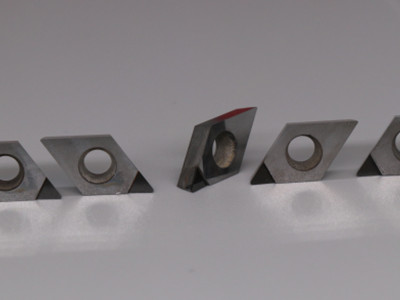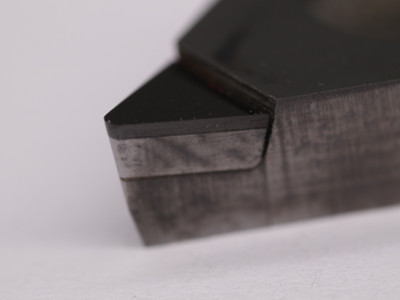

1.Wear: Tools are inevitably subject to wear during machining. The cutting and friction of materials will cause tool surface wear, especially in high-speed, high-temperature and high-pressure environments, the wear will be more obvious. Grinding can restore the cutting performance of the tool and extend its service life.
2.Edge quality recovery: During use, the cutting edge of the tool may be subject to micro-cracks, deformation or other damage, which will affect processing quality and efficiency. Through grinding, the cutting edge can be repaired, so that the tool can regain the designed size and shape and improve the processing quality.
3.Cutting edge regeneration: One of the advantages of PCD tools is their hardness and wear resistance, but it can also cause deformation and wear of the cutting edge of the tool. Through grinding, the cutting edge can be reworked and regenerated, restoring its cutting performance.
4.Cost considerations: PCD tools are relatively expensive, and the cost of regrinding is relatively low. Regular grinding can extend the service life of tools, reduce processing costs, and improve production efficiency.
Therefore, regular grinding of PCD cutting tools is an important means to maintain tool performance, extend service life and reduce processing costs.


·Extremely high hardness and wear resistance. PCD diamond blades have high hardness and their wear resistance is better than other tool materials, so they perform well in high-speed, high-precision machining. ·Low friction coefficient. PCD diamond blades have a low friction coefficient, which can reduce cutting force, lower cutting temperature, and improve processing efficiency.
·The blade is very sharp. PCD diamond blades have sharp edges and can achieve high-precision, high-quality cutting. ·High thermal conductivity. PCD diamond blades have high thermal conductivity and can quickly conduct heat generated during the cutting process to avoid thermal damage to the blade.
·Low thermal expansion coefficient. PCD diamond blades have a low thermal expansion coefficient, which can maintain the dimensional stability of the blade and improve processing accuracy.
·Extremely high impact toughness. PCD diamond blades have high impact toughness, can withstand large cutting forces and impact forces, and extend the service life of the tool.
In addition, PCD diamond blades also have good electrical conductivity and can be processed by wire cutting or electric discharge machining, so they are irreplaceable by other types of diamond in the production of complex tools.
1. PCD tool grinding machine selection: Choosing a stable and high-precision grinding machine is the key to ensuring the grinding effect. Ensure that the spindle accuracy, grinding wheel speed and feed speed of the grinding machine can meet the needs of PCD blade grinding.
2. Grinding wheel selection: Select the appropriate grinding wheel type and particle size based on the material and wear of the PCD blade. Generally, ceramic diamond grinding wheels are ideal for sharpening PCD inserts because of their high hardness and wear resistance.
3. Use of coolant: During the grinding process, the use of coolant can effectively reduce the blade temperature and reduce thermal damage. Water-based coolant should be used for grinding PCD tools.
PCD cutting tools regrinding skills
1. Control the grinding depth: The grinding depth of PCD blades should be controlled within a certain range to avoid blade damage caused by excessive grinding. The grinding depth is controlled by adjusting the feed speed of the grinder and the particle size of the grinding wheel.
2. Uniform grinding: Ensure that every part of the blade is evenly ground to avoid uneven edges. Uniform grinding can be achieved by adjusting the angle and position of the grinder.
3. Pay attention to the grinding sequence: choose the appropriate grinding sequence according to the wear condition of the blade. Usually, start with the more severely worn parts and then gradually transition to other parts.
After grinding is completed, it is crucial to conduct detailed inspection and adjustment of the PCD diamond blade. This not only ensures the best performance of the blade, but also prevents potential problems, thereby ensuring the stability and efficiency of the processing process.
Visual inspection: First, perform a visual inspection of the sharpened blade to ensure there are no cracks, chipping, or other obvious damage. Pay special attention to the edges and corners of the blade, which are most susceptible to damage during the sharpening process.
Edge Inspection: Use a magnifying glass or microscope to carefully inspect the blade's edge. The cutting edge should be smooth and flat, without burrs or unevenness. If the edge is found to be insufficiently sharp or defective, further sharpening or adjustments may be required.
Dimensional Measurements: Use a precise measuring tool, such as a micrometer or optical projector, to measure the size and angle of the blade. Make sure that the size of the sharpened blade meets the processing requirements and check that the angle is correct. If deviations in size or angle are found, corresponding adjustments need to be made.
Performance test: Carry out performance test during the actual machining process to observe the cutting effect, cutting force and cutting temperature of the blade. If poor performance is found, it may be necessary to readjust the grinding parameters or replace the grinding wheel to obtain better grinding results.
Balance check: For PCD diamond blades that require high-speed rotation, balance is very important. Use a dynamic balancing machine to check the balance of the blade to ensure it remains stable when rotating at high speeds. If an imbalance is found, appropriate adjustments or corrections need to be made.
Recording and feedback: Record the blade after each grinding, including grinding parameters, inspection results, performance and other information. This helps analyze problems and improvement measures during the grinding process, and continuously improve grinding quality and efficiency. At the same time, maintain communication with the processing workshop and provide timely feedback on the use and problems of the blade so that the grinding plan can be adjusted in a timely manner.
1. Develop a grinding plan: According to the processing volume and usage, formulate a reasonable grinding plan to ensure that the blade works in the best condition. At the same time, enough time should be reserved for grinding to avoid rush work leading to a decrease in grinding quality.
2. Training and technical improvement: Strengthen the training and technical improvement of CNC grinder tool masters to improve their grinding skills and blade maintenance awareness. Through regular technical exchanges and experience sharing, the technical level of the entire team is continuously improved.
3. Establish grinding records: Keep detailed records of each blade grinding, including grinding time, grinding parameters, grinding results, etc. By analyzing these data, the grinding process and parameter settings are continuously optimized to improve grinding efficiency and quality.
A technical guide to selecting diamond grinding wheels for PDC cutter . Learn how ceramic and resin bond diamond wheels improve efficiency, precision, and tool life in oil & gas and mining applications.
High-performance diamond composite cutters (PDC) for stone cutting saw blades. Learn key structural features, performance requirements, and selection guidelines for granite, marble, and quarry cutting applications.
Add: Zhongyuan Rd, Zhongyuan District, Zhengzhou, 450001, Henan, China
Tel: +86 17700605088